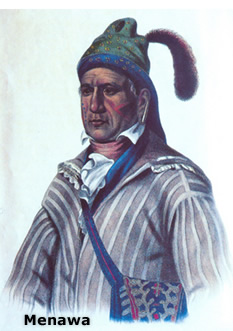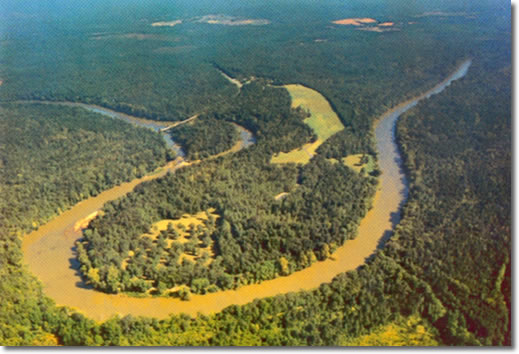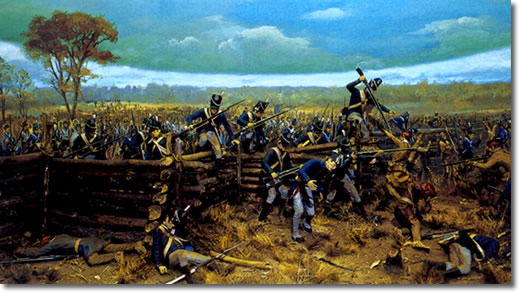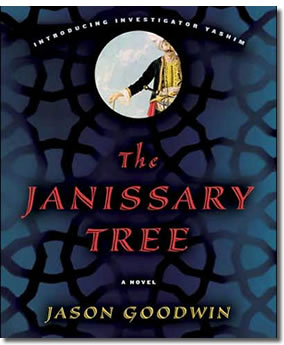On The Road Scholar’s Road Again:
Horseshoe Bend,
Valley, and a Reunion
“It is said that God is always for the big battalions.”
— Voltaire.
By Ron Fritze from Athens, Alabama
Posted September 2, 2008
As you may know from an earlier essay, I participate in the Road Scholar program of the Alabama Humanities Foundation. Currently I am offering a lecture about the myth of Prince Madoc and the Welsh Indians in America. Back in May I got an invitation to give my lecture at the H. Grady Bradshaw Public Library of Valley, Alabama, on 24 July. At first glance I did not know where Valley was, although I soon realized that I had driven past it on I-85 on the way to Atlanta. It is right on the Alabama-Georgia border.
The trip down to Valley is about four hours from Athens, Alabama. A large part of the route follows Highway 280 from Birmingham to Opelika. As I planned my trip I discovered that traveling along Highway 280 would take me past the Horseshoe Bend Battlefield Park. So when I left Athens at noon on 23 July, I planned a stop at Horseshoe Bend.
Alliances in a Time of Anger.
The Battle of Horseshoe Bend took place on 27 March 1814 in the context of the War of 1812 between the United States and Great Britain. The various Native American tribes west of the Appalachian Mountains were growing increasingly angry about the American government’s efforts to take ancestral lands away from them. Tecumseh, the chief of the Shawnee, was forming a confederacy of the tribes to oppose the United States, but his efforts to recruit new allies from the southern tribes during 1811 had not produced much in the way of results. The War of 1812 broke out the next year and many Native American tribes decided to take advantage of the situation and fight as allies of the British.
The Creek Tribe of Alabama and Georgia had not joined Tecumseh because the tribe was not united. One faction was pro-American and the other, known as the Red Sticks, was anti-American. Tensions mounted between Creeks and Americans and also among the Creeks. Skirmishes between rival Creeks finally caused an all-out war to break out.
On 30 August 1813, a large war party of Red Sticks attacked Fort Mims about thirty miles from Mobile. Two hundred and fifty people in the fort were killed. Although Americans thought that the ferocious Red Sticks had ruthlessly massacred innocent American settlers — men, women, and children — the fact of the matter was that many of the victims were Creeks opposed to the Red Sticks.
Old Hickory Rises from the Sick Bed.
News of the Fort Mims massacre prompted the Americans to organize an army under the leadership of Andrew Jackson. Jackson had to leave a sick bed to take command and organize the army. Jackson had been put in bed as the result of a fight with Thomas Hart Benton, the future senator for Missouri, and his brother. Taking umbrage with some insult from Jackson, they administered a Benton Brothers’ beat down on the future U.S. president that including wounding him in the arm with a pistol shot. Old Hickory Jackson had a reputation for being tough, but clearly the Benton tag-team were tougher.
Interestingly, John C. Fremont, the great explorer of the American West and the first man nominated by the fledgling Republican Party to run for president, would marry Thomas Hart Benton’s daughter. One can only imagine what it was like to have a man who had laid out Andrew Jackson for a father-in-law.
Jackson quickly led his troops to Talladega, where they defeated a Creek war party, killing some five hundred warriors on 9 November 1813 while suffering few casualties. After that, things bogged down because of a lack of supplies and harsh wilderness conditions, which demoralized the Americans.
The Promise of Divine Intervention.
The next year Jackson gathered a new army and marched against the Creeks. A large body of Creek warriors took up position at a horseshoe bend on the Tallapoosa River where the Indian village of Tohopeka was located.
 Led by Menawa, over a thousand warriors in Tohopeka listened to their shamans promise the Creeks divine intervention, which would allow them to defeat the Americans, despite most of them lacking muskets and being significantly outnumbered.
Led by Menawa, over a thousand warriors in Tohopeka listened to their shamans promise the Creeks divine intervention, which would allow them to defeat the Americans, despite most of them lacking muskets and being significantly outnumbered.
Now for those of us who grew up watching the Walt Disney show on Sunday night, this information comes as quite a shock. (For those of you reading this who grew up with the Disney Channel, it will come as quite a shock that during my culturally deprived childhood in the 1950s, Disney only came on for one hour a week!) In the Disney version — and Disney does try to get most of its history right — Davy Crockett, aka Fess Parker aka Daniel Boone, and his partner George Russel, aka Buddy Ebsen aka Jed Clampett, is prowling the swamps seeking out warlike and fearsome Creeks. In fact Crockett did not have a chance to contribute much to the campaign. The Disney show also indicates that the Creeks were a considerably greater threat than they really were.

For the Creeks, taking up a position at Tohopeka was not a particularly good idea. The aerial picture of Horse Bend shows how the Creeks allowed themselves to be bottled up on the peninsula formed by the horseshoe bend in the Tallapoosa River. To protect their position, the Creeks constructed a barricade with a wall of logs across the narrowest part of the peninsula. The picture of the American attack shows what the barricade looked like.

When Jackson arrived at Horseshoe Bend on the morning of 27 March 1814, his army consisted of about thirty-five hundred troops, which meant that he had Menawa’s force outnumbered by three or four to one. To keep the Creeks from escaping, Jackson sent General John Coffee with seven hundred mounted infantry from the Tennessee militia and six hundred allied Cherokee warriors to take up positions along the shores of the Tallapoosa opposite the Horseshoe Bend peninsula.
Cannons Don't Work, but Cherokees Do.
Meanwhile Jackson with the remaining two thousand Tennessee militia and United States army regulars prepared to attack the Creeks behind their wall of logs. The American army had two cannons to bombard the Creek position, but cannonballs proved to be surprisingly ineffective against the logs. Apparently the logs were soft enough to absorb the impact of the cannonballs without breaking, while the cannons were not large enough for the task.
Around noon the six hundred Cherokee allies decided to cross the Tallapoosa and attack the Creeks from the rear. When word of this action reached Jackson, he ordered his troops to charge the barricade, which was quickly captured after some harsh hand-to-hand combat. Poorly armed, the Creek found themselves trapped. By the time the fighting ended, some eight hundred of the Creeks had been killed, while the Americans only suffered forty-nine killed and a hundred and fifty-four wounded, including Sam Houston, the future victor at the battle of San Jacinto and president (later governor) of Texas.
During the battle Menawa suffered seven wounds and was left for dead. He wasn’t — and escaped. Five months later the Creeks surrendered at Fort Jackson and gave up much of their land to the United States.
Recovery, Revenge, and Escape.
In 1825 a recovered Menawa would kill the collaborationist Creek leader William McIntosh for giving away more lands to the United States. Later in 1828, the United States removed the Creeks to Oklahoma along with the Cherokees and the Choctaw in the tragic episode of the Trail of Tears. Some of the Red Sticks escaped to Florida to join the Seminoles.

The Horseshoe Bend Battlefield Park is a fine place to visit. There is a nice visitor center with informative exhibits about Creek history and the battle they lost in 1814. The center also features a twenty-minute documentary about the battle.
A road through the park takes visitors to the main battlefield locations on the peninsula. Each of the five stops is marked with informative signs. There are also walking paths in the park. As John Tidwell, my host at Valley would later tell me, when kayaking that part of the Tallapoosa, one can almost hear the cries and screams of the Creek. Rather than being the heroic victory depicted by the Disney film about Davy Crockett, the real battle of Horseshoe Bend was more akin to shooting fish in a barrel.
A Jumping Library at Valley.
Driving on to Valley, I checked into a motel, ate supper, and rested up for my lecture the next day. The H. Grady Bradshaw Public Library is a jumping place. When I got there at 10 a.m., just as it was about to open, mothers and children were already lining up to get in. Entering the library, I was greeted by John Tidwell, my host and the organizer of the program, and the library director, Mary Hamilton, a young woman who arrived a few years ago and has transformed the library into the hub of activity that it is.
The building has a large meeting room, which was set up for my lecture. The library runs a lunch and lecture program — lunch for us was barbequed hot dogs. John Tidwell proved to be an interesting correspondent prior to my visit, and I found him to be a thoroughly pleasant individual. He is retired, having moved back to the hometown of his youth.
My program started about 12:30. Everything went well. The audience of some seventy people were attentive and enthusiastic, and I received many good questions after the lecture. These Road Scholar lectures are always fun, allowing me to meet all sorts of marvelous people. Besides John Tidwell, I got to meet Lilian Wilson, a 1942 graduate of Athens State University.
Hello Again after Forty Years.
Another exceptional part of my trip was a visit from a childhood friend, Brad Loar, who came down from Atlanta for the lecture. He is an administrator with the Federal Emergency Management Agency (FEMA) in Atlanta. We had not seen each other for close to forty years, but I recognized him as soon as he came through the door. After the program, we went to a nearby McDonalds to reminisce over coffee. I hope that we can get together again fairly soon as Atlanta is only a few hours drive from Athens.
Once again, my participation in the Road Scholar program paid big personal dividends. I got to visit a historic place, one I’ve talked about in class many times, made some new friends, and enjoyed a long overdue reunion with a very old friend.

Now
for a
Good
Mystery!
On a concluding book note, if you like mysteries, and if you like history, and if you’re looking for something a little different, then I recommend that you try Jason Goodwin’s The Janissary Tree (2006).
Set in Istanbul in 1836, the novel features a protagonist who is a eunuch, the investigator Yashim — and a great story with lots of authentic detail. Previously Goodwin wrote the non-fiction Lords of the Horizon: A History of the Ottoman Empire. Goodwin has a second Yashim mystery out, The Snake Stone, which I very much look forward to reading. Coincidentally, National Public Radio ran a story of Goodwin and his Yashim novels on the morning I wrote this essay, 14 August. You can find the audio in the Book section of the NPR website by clicking this sentence.
A CLOSING NOTE TO MY READERS: It will come as a shock to readers of the Mediterranean Cruise essays, but let me add that no beers were killed, injured, or consumed during the trip to Valley and Horseshoe Bend. Unfortunately, all that beer tasting on the cruise added some completely unneeded poundage, so I am trying to eat more salad!
Ah, yet, ere I descend to the grave,
May I a small house and large garden have;
And a few friends, and many books, both true,
Both wise, and both delightful too!
— Abraham Cowley (1618-1667), The Wish.
Click on the black panther to read Ron Fritze's final report from his sea cruise,
"From Vigo Bay to Home We Go: Rambling 'tween the Itchen and the Scratchen."
|




